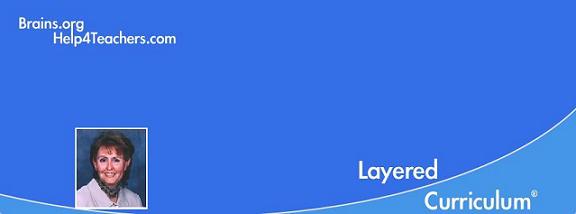__________Layered Curriculum®. . . because every child deserves a special education™_
 |
|
![]() _
_ ![]()
Layered
Curriculum TEXT & WORKBOOK
Set
for only
$43.95
(free shipping in
US)
Tweet
Gaining Control in Your ClassroomBy Dr. Kathie F. Nunley
High school students fight the teacher. Unlike elementary and college classrooms, high school students and teachers seem to have conflicting agendas. Rather than being on the same team, teachers and students often experience the "us versus them" game. Teacher burnout at the secondary level can be attributed to exhaustion from years of this common battle that is rarely discussed. As students graduate high school and move into college they magically change teams. Now the instructors and students seem once more to be on the same side with the same focus of direction, which is to see the student succeed. This change comes from a shift in the student's perception of how much control they have over their learning situation.
Psychologists believe the most important factor in stress level is perception of control. When people feel they have control, they feel less stress. By changing the power structure in your classroom from teacher to student, a teacher can change the student's perception of control. The responsibility for learning shifts from the teacher to the student. This happens when teachers empower students to make their own learning decisions. Now the student, not the teacher, takes the blame or the credit for the education. The student looks to the teacher as a facilitator of learning and the battleground disappears from the classroom. By acknowledging the power or control students have over their own learning, you can ultimately have classes that are "under control". In other words, in order to gain control you have to give up some control.
This shift may be uncomfortable for many teachers. You may need to start small and try to increase the time spent on self-directed study gradually. Here are some simple ideas that can be implemented immediately and return big payoffs in terms of increased learning and reduced stress for both teacher and student:
*Instead of assigning class and homework, offer an assortment of learning activity choices.
*Offer a wide variety of assignments, addressing as many styles and interests as possible. Activities may vary in terms of length of time required and point value.
*Allow the student to choose which assignments they want to do to meet the point requirements for that unit.
*Try to include enough assignment choices so that even the non-readers or low reading ability students can have success.
*Assignment choices may include lecture, video, computer programs, book work, posters, modeling clay, poetry, construction of a board game, flash cards, mobiles, book reports, video performance.
*Allow the students freedom to come up with their own creative assignments. Variety is key to leading rather than managing your students.
About the Author:
Dr Kathie Nunley is an educational psychologist, researcher and author of several books on parenting and teaching, including A Student's Brain (Brains.org) and the best selling, "Differentiating the High School Classroom" (Corwin Press). She is the developer of the Layered Curriculum® method of instruction and has worked with parents and educators around the world to better structure schools to make brain-friendly environments. In addition, her work has been used by the Boeing Corporation, Family Circle Magazine, the Washington Post, and ABC television.
Email her: Kathie (at) brains.orgCopyright © 1998 - current year by Kathie F. Nunley.
All Rights Reserved.
Layered
Curriculum is a registered trademark developed by
Dr. Kathie F. Nunley.